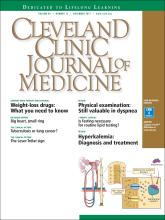A 76-year-old man with ulcerative colitis presented with a 1-week history of low-grade fever and progressive dyspnea. He was taking infliximab for the ulcerative colitis. He was known to be negative for human immunodeficiency virus.
Computed tomography (CT) of the chest revealed infiltrates in the upper lobe of the right lung and right pleural effusion (Figure 1). A sputum smear was positive for acid-fast bacilli, and Mycobacterium tuberculosis was isolated from both sputum and the pleural effusion. He was diagnosed with pulmonary tuberculosis and pleuritis. Infliximab treatment was discontinued and induction chemotherapy for tuberculosis was started.
Computed tomography at the time of presentation showed infiltrates and pleural effusion in the upper lobe of the right lung (A). The left lung appeared normal (B).
After 2 months of combination therapy with isoniazid, rifampicin, ethambutol, and pyrazinamide, maintenance therapy with isoniazid and rifampicin was started. However, after 1 month on maintenance therapy (ie, a total of 3 months of therapy), the patient still had low-grade fever, and repeat chest CT showed randomly distributed nodules mimicking metastatic lung cancer throughout both lungs (Figure 2).
Computed tomography after 3 months of tuberculosis treatment showed randomly distributed nodules in both lungs that resembled metastatic lung cancer.
Since the M tuberculosis cultured from his lung proved to be sensitive to the antituberculosis drugs, we suspected that the nodules were a paradoxical reaction to the drug therapy, and thus we continued the treatment because of the continued low-grade fever. After 9 months of therapy, the fever had resolved and the nodules had disappeared, confirming our suspicion of a paradoxical reaction. The number of lymphocytes gradually increased during drug therapy.
Paradoxical reaction during tuberculosis treatment is defined as a worsening of preexisting lesions or as the emergence of new lesions during appropriate therapy.1,2 The diagnosis is sometimes difficult, since new lesions can resemble other lung diseases. However, a paradoxical reaction involving randomly distributed nodules is rare and radiographically resembles metastatic lung cancer. Clinicians should be aware of this type of reaction in patients on tuberculosis therapy.
- Copyright © 2017 The Cleveland Clinic Foundation. All Rights Reserved.








